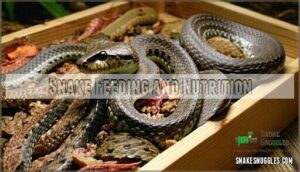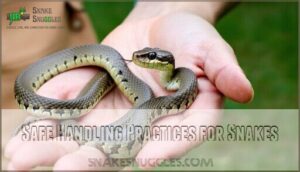This site is supported by our readers. We may earn a commission, at no cost to you, if you purchase through links.

Your snake’s welfare depends on species-specific feeding schedules, temperature gradients between 75-90°F, and UV lighting cycles.
Watch for respiratory infections, skin issues, or behavioral changes that signal illness.
Safe handling involves supporting their body fully while avoiding feeding and shedding periods.
Environmental enrichment through climbing structures, hiding spots, and cognitive challenges prevents stress-related problems.
Annual vet check-ups catch issues early, while proper hygiene protects your family from salmonella risks.
Understanding your snake’s natural behaviors helps you create an environment where they’ll genuinely flourish rather than simply survive, ensuring their overall welfare.
Table Of Contents
- Key Takeaways
- Snake Nutrition and Diet
- Snake Environmental Enrichment
- Snake Habitat and Housing
- Snake Health and Wellness
- Snake Feeding and Nutrition
- Snake Behavioral Enrichment
- Snake Safety and Handling
- Snake Health Risks and Prevention
- Snake Welfare and Ethics
- Advanced Snake Care and Management
- Frequently Asked Questions (FAQs)
- How do you keep a snake healthy?
- Do snakes need veterinary care?
- Do slithery snakes need a vet check-up?
- How do you know if a snake is healthy?
- Are snakes a health hazard?
- How do you handle a snake?
- What is the healthiest food for snakes?
- What is the most common cause of death in snakes?
- What’s the nicest snake to have as a pet?
- What I wish I knew before getting a snake?
- Conclusion
Key Takeaways
- You’ll need to establish proper nutrition with whole prey items like frozen-thawed mice or rats, fed weekly for juveniles and every 10-14 days for adults, matching prey size to your snake’s girth for safe digestion.
- You must maintain precise environmental conditions including temperature gradients of 75-90°F, appropriate humidity levels, and enrichment elements like hiding spots and climbing structures to support natural behaviors and reduce stress.
- You should monitor your snake’s health through daily observation for warning signs like respiratory issues, skin problems, or behavioral changes, plus schedule annual veterinary checkups with reptile-experienced vets for early disease detection.
- You can’t use basic pet care approaches—snakes require species-specific husbandry including proper substrate selection, UV lighting cycles, and understanding that most health issues stem from improper environmental conditions rather than infectious diseases.
Snake Nutrition and Diet
Proper nutrition forms the foundation of snake health, directly impacting everything from bone strength to successful shedding cycles.
You’ll need to understand species-specific dietary requirements and feeding schedules to prevent common nutritional disorders like metabolic bone disease.
Essential Nutrients for Snakes
Your snake’s nutritional foundation requires specific building blocks for peak health. Protein sources from whole prey provide essential amino acids, while calcium needs support bone strength and muscle function.
Quality nutrition builds the foundation for your snake’s vibrant health and longevity.
Essential nutrients from whole prey items fuel your snake’s strength and vitality naturally.
Vitamin supplements and proper mineral balance prevent common nutrient deficiencies like metabolic bone disease. Think of reptile nutrition as a balanced equation—snake diet planning with appropriate dietary supplements guarantees your pet thrives, not just survives.
A well-planned diet must consider water requirements to maintain proper hydration and overall snake health.
Dietary Needs of Different Snake Species
Understanding snake nutrition requires recognizing that species vary dramatically in their feeding habits.
Boas thrive on weekly meals, while garter snakes need frequent small portions to meet their dietary requirements.
Prey selection directly impacts nutrient balance – what works for one species won’t suit another.
Dietary supplements can address nutritional gaps in captive reptile nutrition programs.
- Ball pythons prefer rats every 10-14 days
- Corn snakes do well with weekly mouse meals
- King snakes need slightly larger prey items
Your snake feeding success depends on matching food to species-specific needs.
Variety of Food Options for Snakes
When you’ve mapped your snake’s specific needs, prey variety becomes your next priority.
Snake diets thrive on options like mice, rats, and quail—frozen, thawed options beat live feeding for safety.
Food supplements can fill nutritional gaps when recommended by vets.
Different feeding techniques work for different species, but whole prey remains king for proper snake nutrition.
Foods That Are Safe for Snakes to Eat
When choosing safe foods for your pet snake, you’re looking at whole prey that delivers complete nutrition. Frozen rodents like mice and rats form the backbone of proper snake nutrition, offering balanced rodent nutrition that matches your snake’s natural dietary needs. These frozen prey items eliminate parasite risks while maintaining nutritional value.
Prey size matters tremendously – think of it as finding the perfect-fitting shoe for your snake’s digestive system. Birds like chicks and quail work well for certain species, while fish suits aquatic snakes when properly supplemented. Commercial reptile sausages provide convenient alternatives for picky eaters.
Live prey poses injury risks, making frozen rodents the safer choice. Proper feeding practices mean thawing prey to room temperature and selecting appropriate sizes. Supplementing diet becomes necessary only with fish or specialized feeds.
- Whole mice and rats provide complete, balanced nutrition
- Appropriately sized prey prevents digestive complications
- Frozen options eliminate parasites while maintaining nutrients
- Species-specific choices support natural feeding behaviors
Understanding snake dietary needs involves researching snake nutritional requirements to guarantee a healthy pet.
Foods That Should Be Avoided or Restricted for Snakes
While you’ve identified safe foods, toxic ingredients can seriously harm your snake.
Toxic Foods like avocados contain persin, which causes severe Snake Poisoning.
Bad Nutrition from inappropriate prey leads to digestive problems and metabolic disorders.
| Avoid These Foods | Health Risk |
|---|---|
| Avocados | Toxic persin compound |
| Pork products | Poor digestive health |
| Wild insects | Parasites and diseases |
Restricted Diets should exclude any food outside whole prey items.
Your snake’s nutrition depends on species-appropriate feeding practices that support ideal digestive health.
Potential Health Risks Associated With Improper Snake Food Choices
Poor dietary choices can wreck your snake’s health faster than you’d think.
Malnutrition effects from feeding errors include metabolic bone disease, digestive issues, and respiratory infections. Dietary toxins and nutrient deficiencies create serious health consequences affecting your pet’s wellbeing.
- Metabolic bone disease from calcium deficiency causes weak bones and deformities
- Digestive issues from improper prey size lead to regurgitation and blockages
- Respiratory infections often develop from weakened immunity due to poor nutrition
Snake Environmental Enrichment
Creating an enriched environment for your snake isn’t just about aesthetics—it’s essential for their mental and physical well-being.
You’ll discover how thoughtful habitat modifications can transform a simple enclosure into a stimulating home that encourages natural behaviors and reduces stress.
What is Environmental Enrichment for Snakes?
Environmental enrichment transforms your snake’s basic habitat into a dynamic, stimulating environment that promotes natural behaviors and psychological well-being.
Transform a boring cage into your snake’s personal wonderland through thoughtful enrichment
Unlike simple housing, enrichment involves strategic habitat design incorporating elements for cognitive stimulation, physical activity, and sensory experience.
This approach encourages behavioral diversity, reducing stress while supporting ideal snake welfare.
Think of it as upgrading from a bare apartment to a fully furnished home that meets your pet’s instinctual needs, providing a setting for natural behaviors and overall psychological well-being.
Cognitive Enrichment for Snakes
Your snake’s brain craves mental workouts just like yours does.
Problem solving activities and food puzzles create environmental complexity that sparks cognitive growth.
Research shows enrichment literally enlarges snake brains!
Hide meals in containers, create mazes, or rotate décor weekly.
This mental stimulation transforms basic behavior into engaged exploration, making your snake environment a playground for curious minds seeking sensory stimulation.
Physical Enrichment for Snakes
While cognitive enrichment engages your snake’s mind, physical enrichment transforms their habitat into an active playground.
Create climbing structures using sturdy branches and rock arrangements to encourage natural movement patterns. Strategic branch placement at different heights promotes exercise, while varied substrate textures provide sensory stimulation.
Environmental variety keeps your snake physically engaged and mentally sharp.
- Climbing Structures – Install branches at multiple levels for vertical exploration
- Rock Arrangements – Create caves and basking spots with proper temperature zones
- Substrate Variety – Mix textures to stimulate natural burrowing behaviors
Sensory Enrichment for Snakes
Sensory stimulation transforms your snake’s habitat into an engaging wonderland that promotes natural behaviors and enhances welfare.
Visual stimulation through colorful branches and varied textures encourages exploration, while olfactory enrichment using natural scents like herbs activates their incredible sense of smell.
Tactile exploration opportunities with different surface textures satisfy their need to investigate their environment through touch.
Using Food as Enrichment for Snakes
Food enrichment transforms mealtime into mental stimulation for your snake.
Vary rodent prey sizes and feeding techniques to encourage natural foraging behaviors.
Hide food items throughout the enclosure or use feeding puzzles to challenge your pet’s problem-solving skills.
Different prey presentation methods—such as using tongs or strategic placement—keep snake feeding practices interesting while supporting proper snake nutrition and reducing stress-related behaviors.
Social Enrichment for Snakes
Unlike their reptilian reputation suggests, most snakes aren’t naturally social creatures and don’t benefit from Snake Interaction with other snakes.
However, you can provide Environmental Stimulation through controlled socialization with their human caregivers during feeding and handling sessions.
- Monitor stress indicators during any interaction attempts
- Maintain separate habitat spaces to prevent territorial disputes
- Use Behavioral Modification techniques during supervised encounters
- Focus enrichment efforts on individual behavior enhancement rather than Community Building
Snake Habitat and Housing
Creating the perfect snake habitat isn’t rocket science, but it does require attention to specific details that directly impact your pet’s health and happiness.
You’ll need to balance enclosure size, substrate choice, temperature gradients, and enrichment elements to replicate your snake’s natural environment and promote essential behaviors like thermoregulation and exploration.
Setting Up a Snake’s Terrarium
Creating the perfect snake habitat starts with selecting proper Enclosure Size – typically 20-40 gallons depending on species.
Your terrarium needs strategic Hiding Spots on both warm and cool sides for security.
| Component | Specification |
|---|---|
| Enclosure Size | 20-40+ gallon tank |
| Temperature Gradients | 75-80°F cool, 85-90°F warm |
| Hiding Spots | Minimum two (per zone) |
| Water Features | Shallow soaking dish |
| Snake Lighting | 12-hour fluorescent cycle |
Maintain proper snake temperature with heat sources creating essential Temperature Gradients.
Add Water Features like shallow dishes for hydration and shedding support.
Don’t forget climbing branches and rocks – your snake enclosure should mimic nature’s playground while keeping safety paramount.
Choosing the right snake terrarium size is vital for the health and well-being of your pet snake.
Choosing The Right Substrate for Your Snake
Your snake’s bedding materials directly impact humidity control and tank hygiene.
Substrate options like aspen shavings work well for drier environments, while coconut fiber retains moisture for species needing higher humidity.
Avoid cedar or pine—they’re toxic.
Natural substrates like cypress mulch encourage burrowing, but artificial options like reptile carpet simplify cleaning.
Choose based on your snake’s species-specific needs to ensure a healthy environment, considering the best snake bedding options to guarantee a healthy environment with proper snake bedding selection.
Providing Environmental Enrichment in The Terrarium
Beyond substrate selection, terrarium design transforms your snake’s basic enclosure into a thriving habitat.
Environmental variety promotes natural behaviors while reducing stress through sensory stimulation.
Consider these enrichment essentials:
- Snake hides – Place secure retreats on both warm and cool sides
- Climbing structures – Add branches or artificial vines for arboreal species
- Substrate variation – Create different textures within the environment
This habitat diversity encourages exploration and mimics wild conditions.
Temperature and Lighting Requirements for Snakes
Your snake’s thermostat becomes its lifeline—Heat Gradients with warm sides at 85-90°F and cool sides at 75-80°F let them self-regulate.
UVB Lighting on 12-hour Lighting Schedules supports vitamin D3 synthesis.
Your heat source paired with Temperature Control systems prevents the respiratory issues that plague poorly heated enclosures.
Maintaining a Clean and Safe Environment for Snakes
Your snake’s terrarium cleaning routine directly impacts their health and longevity.
Start by picking the right bedding – aspen shavings or cypress mulch provide comfort and proper traction for your pet.
Regularly spot-clean the snake enclosure daily, removing waste and uneaten food immediately.
Make sure there’s good ventilation and maintain species-appropriate humidity levels through proper habitat design.
Complete sanitation and deep cleaning every two weeks prevents bacterial buildup, ensuring ideal snake hygiene and environmental control for your reptilian companion’s well-being.
Snake Health and Wellness
Your snake’s health depends on recognizing warning signs early and maintaining proper veterinary care.
Understanding common health issues like respiratory infections, mites, and metabolic bone disease helps you provide the best care for your scaly companion.
Common Health Issues in Snakes
Respiratory infections, skin problems, and parasite infestations frequently plague captive snakes.
You’ll recognize respiratory issues through wheezing and mouth breathing, while metabolic disorders stem from poor nutrition.
Eye infections and digestive issues can develop from inadequate husbandry.
Snake diseases like scale rot and mites require immediate attention.
Maintaining proper temperature, humidity, and cleanliness prevents most snake illness symptoms from becoming serious health crises.
Signs and Symptoms of Illness in Snakes
Recognizing snake illness symptoms can save your pet’s life.
Watch for these warning signs that indicate your snake needs veterinary attention:
- Respiratory Issues – wheezing, mouth breathing, or excessive mucus
- Skin Lesions – unusual bumps, discoloration, or wounds
- Eye Problems – cloudy eyes, swelling, or discharge
- Behavioral Changes – lethargy, aggression, or hiding constantly
Early detection of snake health issues prevents serious complications and metabolic disorders.
Importance of Annual Check-ups for Snakes
Think of annual checkups as your snake’s health insurance policy – they’re worth every penny.
During these veterinary care sessions, reptile-specialized vets conduct thorough health screens and diagnostic tests to catch problems before they escalate.
Your vet will perform parasite checks, evaluate body condition, and assess habitat requirements.
These snake exams aren’t just about treating illness; they’re about preventative care that keeps your slithery friend thriving for years to come.
- Schedule annual checkups with reptile-experienced veterinarians
- Request thorough parasite checks and fecal examinations
- Discuss proper nutrition and environmental requirements during visits
- Monitor weight trends and body condition scoring
- Establish baseline health parameters for future snake veterinary comparisons
Managing Stress in Snakes
When your snake acts like it’s auditioning for a stressed-out reality show, it’s time for stress reduction interventions.
Recognizing snake stress signs helps you create calming environmental changes. Proper handling techniques and relaxation methods transform anxious serpents into content companions, promoting ideal snake health and snake welfare.
| Stress Indicator | Management Strategy |
|---|---|
| Excessive hiding | Increase hiding spots |
| Aggressive striking | Reduce handling frequency |
| Refusal to eat | Check temperature gradients |
| Constant movement | Provide secure retreats |
| Abnormal posturing | Evaluate habitat conditions |
Preventing Disease in Snakes
Disease prevention starts with bulletproof quarantine protocols—isolate new snakes for thirty days minimum.
Daily spot-cleaning and weekly disinfection using sodium hypochlorite solutions eliminate harmful pathogens.
Monitor your snake’s weight quarterly and watch for lethargy or respiratory symptoms.
Maintain stable temperatures and humidity levels to boost immune function.
Remember, consistent veterinary care and proper hygiene practices beat expensive treatments every time.
Snake Feeding and Nutrition
Proper nutrition forms the foundation of your snake’s health, requiring species-specific dietary planning and careful attention to feeding protocols.
You’ll need to understand essential nutrients, appropriate prey sizing, and feeding frequencies to prevent common nutritional disorders like metabolic bone disease.
Feeding Your Snake a Balanced Diet
Proper snake nutrition forms the foundation of your pet’s digestive health and overall well-being.
Your snake requires a diet of whole prey items like mice or rats, matched precisely to their girth for safe consumption. Feed juveniles weekly while adults eat every 10-14 days according to species-specific meal scheduling requirements.
Supplement with veterinarian-recommended nutrients to prevent metabolic bone disease. Snake food safety demands frozen, thawed rodents over live prey to avoid injuries and guarantee healthy diet plans.
Understanding the risks of extreme fasting methods is vital for maintaining a balanced and healthy diet for your pet snake, ensuring a proper digestive health and overall well-being with the right diet plans.
How to Choose The Right Food for Your Snake
Choosing ideal snake food starts with understanding your pet’s carnivorous dietary needs.
Select whole prey items like frozen-thawed mice or rats that match your snake’s girth for safe consumption.
Consider your snake’s species-specific feeding schedule and prey size requirements.
Quality snake nutrition depends on appropriate food safety practices and matching dietary needs to natural hunting behaviors.
Proper snake care also involves researching suitable snake food options to guarantee a balanced diet.
This includes understanding the importance of natural hunting behaviors in determining the right food for your pet.
Feeding Environment and Safety Tips
Creating a safe feeding environment protects both you and your snake during meals.
Use separate feeding containers to maintain tank setup cleanliness and prevent substrate ingestion.
Position water quality bowls nearby for hydration. Never handle snakes during feeding—they’re in predator mode!
Maintain proper temperature gradient and humidity control in feeding areas.
These feeding tips guarantee stress-free meals while supporting superior food safety practices.
How Often to Feed Your Snake
Your snake’s feeding schedule depends on age and species.
Young snakes typically need weekly meals, while adults eat every 10-14 days.
Feeding frequency affects snake growth and health.
Monitor your pet’s body condition—overfeeding causes obesity, underfeeding stunts development.
Snake digestion takes days, so don’t rush the process.
Adjust meal frequency based on your snake’s individual dietary needs for ideal nutrient balance.
Dealing With Feeding Issues in Snakes
While proper feeding frequency keeps most snakes healthy, even the best-fed serpents sometimes develop feeding problems.
When your snake won’t eat, stay calm—appetite loss happens more often than you’d think.
Common feeding issues require systematic solutions:
- Food refusal often signals stress, illness, or environmental problems requiring immediate attention
- Snake regurgitation indicates feeding frequency mistakes, improper temperatures, or handling too soon after meals
- Appetite loss during shedding cycles is normal, but persistent refusal needs veterinary evaluation
- Digestive symptoms like bloating suggest prey size issues affecting snake digestion and overall digestive health
Monitor your snake’s behavior closely and adjust accordingly.
Snake Behavioral Enrichment
Your snake’s mental well-being depends on environmental enrichment that mimics natural behaviors and reduces captivity stress.
Behavioral enrichment transforms a basic enclosure into an engaging habitat that promotes physical activity, cognitive stimulation, and species-appropriate responses.
Understanding Snake Behavior
Snake behavior reveals fascinating insights through behavioral cues and snake body language. Your pet snake‘s stress signals include rapid tongue flicking and frantic movement, while relaxed snakes display slow, deliberate habitat exploration.
Understanding these patterns improves snake welfare and snake health. Unlike mammals, snakes have minimal social interactions, preferring solitude.
Recognizing normal behavior versus distress helps you create ideal environments for your serpentine companion.
Providing Behavioral Enrichment for Snakes
Now that you understand your snake’s natural instincts, you’ll want to provide behavioral enrichment that keeps them mentally sharp and physically active.
Snake toys like puzzle feeders and varied textures create environmental stimulation that mimics wild conditions.
Sensory activities including scent trails and climbing structures encourage exploration, while strategic habitat design promotes natural behaviors.
These enrichment techniques transform basic housing into dynamic environments where snakes thrive through meaningful stimulation and interaction.
Encouraging Natural Behaviors in Snakes
Captive snakes thrive when environmental stimulation mirrors their wild counterparts’ daily routines.
Creating opportunities for snake exploration supports psychological well-being through behavioral diversity.
- Natural Foraging: Hide prey items throughout enclosures to stimulate hunting instincts and problem-solving behaviors
- Habitat Enrichment: Provide climbing branches, varied substrates, and multiple hiding spots for species-appropriate movement patterns
- Environmental Rotation: Regularly rearrange habitat features to prevent habituation and encourage continued exploration
- Temperature Gradient Utilization: Design thermal zones that promote natural thermoregulatory behaviors and activity cycles
These enrichment strategies enhance snake welfare while supporting healthy snake behavior patterns.
Dealing With Abnormal Behaviors in Snakes
Unusual behaviors like abnormal posture, constant escape attempts, and feeding problems signal distress in your snake.
Stress signals include excessive hiding, aggression, or abnormal shedding patterns.
These behavioral issues often stem from improper temperatures, inadequate hiding spots, or poor habitat conditions.
Don’t panic—most problems resolve with environmental adjustments.
Check your setup first: temperature gradients, humidity levels, and enrichment options.
Your snake’s telling you something’s off, so listen up and make those tweaks!
Using Enrichment to Reduce Stress in Snakes
Creating effective enrichment activities transforms your snake’s habitat into a stress-busting sanctuary.
Environmental toys and sensory stimulation promote natural behavior while reducing anxiety.
Here’s your stress reduction toolkit:
- Rotate hiding spots weekly to encourage exploration
- Add climbing branches for physical exercise and mental engagement
- Introduce safe scents like shed skin for olfactory enrichment
- Provide snake puzzles using feeding tubes or paper towel rolls
- Vary substrate textures to stimulate tactile senses
Watch your snake’s behavior closely—increased activity and confident exploration signal successful enrichment implementation.
Snake Safety and Handling
Safe handling protects both you and your snake from injury while building trust through consistent, gentle interactions.
You’ll need to master proper techniques and recognize warning signs to guarantee every handling session remains stress-free and secure.
Safe Handling Practices for Snakes
Why rush when proper snake handling keeps everyone safe? Snake handling requires patience and technique to prevent stress and injury.
Follow these essentials: Move slowly, support the body completely, and maintain gentle but secure snake restraint. Handling techniques vary by species—smaller snakes need lighter grip while larger species require firmer control.
| Handling Phase | Key Action | Safety Focus |
|---|---|---|
| Approach | Move deliberately | Reduce startle response |
| Initial Contact | Support mid-body first | Distribute weight evenly |
| Lifting | Use both hands | Prevent dropping injuries |
| Restraint | Gentle but secure grip | Avoid escape attempts |
| Return | Lower slowly to surface | Escape prevention priority |
Snake handling safety means washing hands before and after contact, ensuring venomous safety protocols if applicable, and never grabbing the head or tail. These snake handling techniques become second nature with practice.
How to Handle Your Snake Safely
Safe snake handling starts with proper timing—never handle during feeding or shedding periods.
Support your snake’s body weight using both hands, maintaining gentle restraint without squeezing. Move slowly and confidently, as snakes detect nervousness through vibrations.
Keep sessions brief to minimize stress. These snake handling techniques guarantee snake safety while preventing escape through secure, controlled movements.
Safety Tips for Snake Owners
Owning a snake means thinking like a security expert. Snake proofing your home starts with escape-proof enclosures—secure latches aren’t optional.
Master snake handling basics: move slowly, support their body, never grab just the head.
Emergency response planning matters, even for non-venomous species. Keep your vet’s number handy and know basic first aid.
Remember, venomous safety research applies if you’re considering advanced species later.
Dealing With Snake Bites and Emergencies
Snake bites and emergencies require immediate action—don’t panic, but move fast.
Most pet snake bites aren’t venomous, but proper first aid prevents infection and complications.
Emergency response protocol:
- Stay calm and assess the bite severity
- Clean the wound with soap and water immediately
- Apply pressure to control bleeding using sterile gauze
- Seek medical attention if swelling, severe pain, or systemic symptoms occur
- Document the incident including snake species for medical professionals
Precautions for Pregnant Women and Children
Expecting mothers and families with young ones need extra vigilance around snakes due to Salmonella risks.
Pregnancy Risks include bacterial transmission that could harm developing babies. Child Safety requires supervised Snake Handling only.
Essential Family Precautions include thorough handwashing after any contact and maintaining spotless habitats.
Household Measures should address allergies – snake dander triggers reactions in sensitive individuals. Never allow unsupervised access to venomous snakes.
With proper precautions, families can safely enjoy these fascinating pets.
Snake Health Risks and Prevention
Preventing health issues in your snake starts with recognizing early warning signs and maintaining proper husbandry practices.
You’ll save yourself costly vet bills and keep your slithery friend thriving by staying vigilant about common problems like respiratory infections, mites, and digestive issues.
Common Health Risks in Snakes
Health issues can sneak up on your snake faster than you’d expect.
Understanding common snake diseases helps you catch problems early and keep your pet thriving.
Watch for these major health risks:
- Metabolic Disease – Poor nutrition causing bone weakness and organ dysfunction
- Respiratory Issues – Infections leading to mouth breathing and wheezing sounds
- Parasite Control problems – Internal worms or external mites causing lethargy
- Skin Problems – Stuck sheds, scale rot, or bacterial infections
- Infections – Bacterial or fungal issues from poor hygiene conditions
Regular monitoring of snake health is vital to identify and address common health issues promptly.
How to Identify Health Issues in Snakes
Recognizing snake symptoms early can save your pet’s life.
Watch for changes in shedding patterns, appetite loss, labored breathing, or snake skin problems like lesions.
Health checks should include observing behavior, skin condition, and eating habits.
Unusual lethargy, mouth rot, or snake respiratory health issues require immediate veterinary care for proper disease diagnosis and medical treatment.
Importance of Vaccinations for Snakes
Snake vaccinations remain unavailable, making disease prevention your primary defense strategy.
Unlike dogs or cats, no licensed vaccines exist for snakes against infectious diseases. Current reptile immunology research hasn’t produced approved snake vaccines, leaving veterinary care focused on prevention through proper husbandry.
Here’s what snake wellness plans emphasize instead:
- Annual veterinary checkups for early disease detection
- Strict quarantine protocols for new snakes
- Optimal environmental conditions reducing stress-related illness
- Proper hygiene practices preventing bacterial infections
- Regular health monitoring catching issues before they spread
Herpetology care relies on biosecurity rather than immunization for disease prevention.
How to Keep Your Snake Healthy
Success starts with proper snake hygiene and consistent health checks. You’ll need regular veterinary care, daily snake monitoring, and quick emergency response skills.
- Clean habitat maintenance: Fresh water, spot-cleaned substrate, and disinfected surfaces prevent bacterial infections
- Weekly health assessments: Check for mites, stuck shed, respiratory issues, and appetite changes during snake care
- Temperature monitoring: Maintain species-specific gradients using reliable thermostats for ideal reptile health
- Quarantine protocols: Isolate new snakes for 30-60 days before introducing to established collections
- Emergency preparedness: Know your exotic vet’s contact info and recognize signs requiring immediate snake welfare intervention
Snake Welfare and Ethics
Keeping snakes as pets comes with significant ethical responsibilities that require careful consideration of their complex welfare needs.
You’ll need to understand both the moral implications of confining wild-adapted animals and the scientific principles that guarantee their psychological and physical well-being in captivity.
Importance of Animal Welfare for Snakes
Why prioritize animal welfare for your pet snake? Snake welfare encompasses more than basic survival—it means creating conditions where your snake can express natural behaviors and thrive emotionally.
Proper welfare standards include enrichment opportunities, stress monitoring, and humane treatment that supports both reptile health and conservation efforts, ensuring your snake experiences genuine well-being.
Implementing ethical handling practices is essential for providing a safe and healthy environment for your pet snake.
Ethics of Keeping Snakes as Pets
Owning a snake isn’t just about wanting an exotic pet—it’s about understanding animal ethics and captivity concerns. Pet owner rights come with serious responsibilities, especially when snake welfare hangs in the balance.
Before committing to pet snake ownership, you’ll need to examine whether keeping these wild animals captive truly serves their best interests or just satisfies human curiosity.
- Snake welfare studies show 54.7% of captive snakes live in enclosures shorter than their body length
- Responsible breeding practices require avoiding suppliers with documented neglect and poor conditions
- Animal ethics experts question whether snakes experience genuine contentment in domestic settings
- Snake care demands species-specific expertise that many owners lack, leading to chronic stress
Ensuring The Well-being of Snakes in Captivity
Well-being in captivity hinges on meeting your snake’s physical and psychological needs.
Proper captive care involves species-appropriate temperatures, humidity, and Animal Enrichment like climbing structures.
Monitor Snake Behavior for stress indicators—abnormal movement patterns or feeding refusal signal welfare issues.
Reptile Wellness requires spacious enclosures with hiding spots that promote natural behaviors.
Quality captive snake care supports both snake health and Species Conservation efforts.
Dealing With Welfare Concerns in Snakes
When you spot snake stress or behavioral changes, act fast—these signs often reveal serious welfare issues that need immediate attention.
Welfare checks aren’t just nice gestures; they’re essential for maintaining snake health and supporting broader conservation efforts.
- Monitor for stress indicators like defensive posturing, appetite loss, or excessive hiding behaviors
- Document behavioral patterns during welfare checks to identify emerging health problems early
- Address husbandry deficiencies promptly—poor temperature gradients and inadequate enrichment compromise animal rights
- Consult veterinary professionals when snake behavior suggests underlying medical or psychological distress
Promoting Positive Snake Welfare
Creating positive snake welfare means treating your reptile like the remarkable creature it deserves to be.
Enrichment activities become your snake’s daily adventures—climbing branches reduce snake stress while promoting natural behaviors.
Welfare ethics guide every decision, from habitat design to feeding schedules.
Conservation efforts start in your terrarium, where understanding animal emotions helps you recognize contentment.
Quality reptile care transforms your pet’s world into a thriving ecosystem that respects reptile rights.
Advanced Snake Care and Management
Once you’ve mastered basic snake care, advanced techniques can transform your reptile’s quality of life through specialized breeding protocols and environmental optimization.
These evidence-based strategies help you create professional-grade habitats that promote natural behaviors while maintaining precise health monitoring systems, which can lead to a better understanding of your reptile’s needs and environmental optimization.
Advanced Techniques for Snake Care
Advanced snake care demands precision in Environmental Control and Snake Monitoring systems.
You’ll excel by implementing automated temperature gradients, humidity sensors, and Advanced Feeding protocols adapted to individual Snake Behavior patterns.
Preventative care includes regular veterinary care assessments and biosecurity measures.
These advanced techniques transform basic snake care into thorough snake health management, ensuring your serpentine companions thrive like well-oiled machines.
Managing Snake Collections and Breeding Programs
Snake collections require systematic approaches that balance animal welfare with genetic diversity.
You’ll need detailed recordkeeping for lineage tracking and health monitoring—think of it as creating family trees for your scaly friends.
- Breeding Strategies focus on genetic diversity to prevent inbreeding depression
- Collection Management software streamlines inventory and health records
- Species Conservation protocols maintain bloodline integrity through careful pairing
- Snake Health monitoring includes quarantine procedures and regular veterinary assessments
These elements work together to ensure the well-being and diversity of the snakes in the collection.
Advanced Enrichment Techniques for Snakes
Breeding programs demand precision, but your snakes need more than basic care—they require sophisticated Environmental Design that transforms their world.
Advanced Sensory Stimulation through rotating scents, textures, and visual barriers creates dynamic habitats that support ideal snake welfare and encourage natural snake behavior.
| Enrichment Type | Advanced Technique | Behavioral Impact |
|---|---|---|
| Cognitive Training | Puzzle feeders with multiple chambers | Enhances problem-solving abilities |
| Sensory Stimulation | Rotational scent trails from prey species | Triggers natural hunting responses |
| Physical Enrichment | Multi-level climbing structures | Promotes muscle development |
| Environmental Design | Temperature-controlled microclimates | Supports thermoregulation choices |
| Behavioral Modification | Scheduled enrichment rotation | Prevents habituation and boredom |
Habitat Optimization through these snake enrichment techniques transforms static enclosures into dynamic ecosystems that promote psychological well-being.
How to Create a Snake-Friendly Environment
Every successful snake owner knows that habitat design transforms ordinary snake enclosures into thriving ecosystems.
Your snake’s environment needs careful attention to environmental factors like temperature gradients and humidity levels for peak health.
Key space optimization strategies include:
- Install multiple hiding spots across temperature zones
- Add climbing branches for enrichment and exercise
- Maintain proper substrate depth for burrowing species
Effective terrarium maintenance involves weekly cleaning routines and daily spot-checks to guarantee your snake’s habitat remains pristine and stress-free.
Advanced Snake Health and Wellness Strategies
Implementing snake genetics knowledge helps you identify hereditary conditions before they develop.
Regular health monitoring through monthly weight checks and behavior assessments catches issues early.
Extensive wellness plans combining preventative care with veterinary expertise guarantee superior snake health.
Professional veterinary care paired with proactive disease prevention strategies creates a foundation for lifelong snake wellness success.
Frequently Asked Questions (FAQs)
How do you keep a snake healthy?
Picture your snake coiled contentedly in its perfect habitat—that’s achievable!
You’ll provide proper-sized frozen prey weekly, maintain temperature gradients between 70-85°F.
Guarantee clean water daily, and create secure hiding spots for peak health.
Do snakes need veterinary care?
Yes, you’ll need regular veterinary check-ups for your snake.
Find an exotic animal vet who understands reptiles.
They’ll monitor health, treat parasites, and catch problems early before they become serious issues.
Do slithery snakes need a vet check-up?
Nearly 80% of reptile health issues stem from improper husbandry rather than infectious diseases.
You’ll need annual vet checkups for your snake to catch nutritional deficiencies, parasites, and metabolic bone disease early—prevention beats treatment every time.
How do you know if a snake is healthy?
You’ll know your snake’s healthy by checking for clear eyes, smooth shedding, regular eating habits, appropriate body weight, active behavior, and clean breathing without wheezing or mouth-breathing issues.
Are snakes a health hazard?
Contrary to scary myths, you’re unlikely to catch diseases from pet snakes with proper hygiene. They can carry Salmonella, but regular handwashing after handling eliminates risk completely.
How do you handle a snake?
Support your snake’s body properly by placing one hand behind its head and another mid-body.
Move slowly, stay calm, and let it settle before handling.
Never grab just the tail—you’ll stress your slithery friend unnecessarily, and always remember to handle them with care.
What is the healthiest food for snakes?
Frozen-thawed whole prey like mice and rats deliver unbeatable nutritional completeness for your snake.
You’ll avoid the feeding frenzy of live prey while providing essential calcium, protein, and vitamins that keep your serpent thriving beautifully.
What is the most common cause of death in snakes?
Improper husbandry causes most captive snake deaths.
75% of "pet" reptiles, including snakes, die within one year—many from stress related to captivity.
Poor temperature control and inadequate humidity frequently trigger respiratory infections, which you’ll spot as the primary killer, often resulting from stress.
What’s the nicest snake to have as a pet?
Many snake enthusiasts consider ball pythons the "starter snake" for good reason. They’re docile, manageable at 3-5 feet, rarely bite, and tolerate handling well, making them perfect companions.
What I wish I knew before getting a snake?
You’ll need proper equipment, space for a 20-gallon minimum enclosure, temperature controls, and weekly feeding schedules. Research species-specific needs thoroughly—snakes aren’t low-maintenance pets despite popular belief.
Conclusion
Mastering snake health and welfare transforms your cold-blooded companion from a mere pet into a thriving family member.
You’ve learned that proper nutrition, environmental enrichment, and vigilant health monitoring create the foundation for snake wellness.
Remember, your snake can’t tell you when something’s wrong—watching for subtle behavioral changes becomes your superpower.
By implementing species-specific care protocols and maintaining consistent veterinary relationships, you’re ensuring your scaly friend lives their best life.
Excellence in snake health and welfare isn’t luck—it’s dedication.
- https://vcahospitals.com/know-your-pet/snakes-diseases
- https://amccorona.com/wp-content/uploads/2018/03/ARAV_trifold_cornsnake_4-24.pdf
- https://www.petsmart.com/learning-center/reptile-care/snake-care-guide-how-to-take-care-of-a-pet-snake./A0042.html
- https://pmc.ncbi.nlm.nih.gov/articles/PMC9239482/
- https://www.merckvetmanual.com/all-other-pets/reptiles/disorders-and-diseases-of-reptiles























